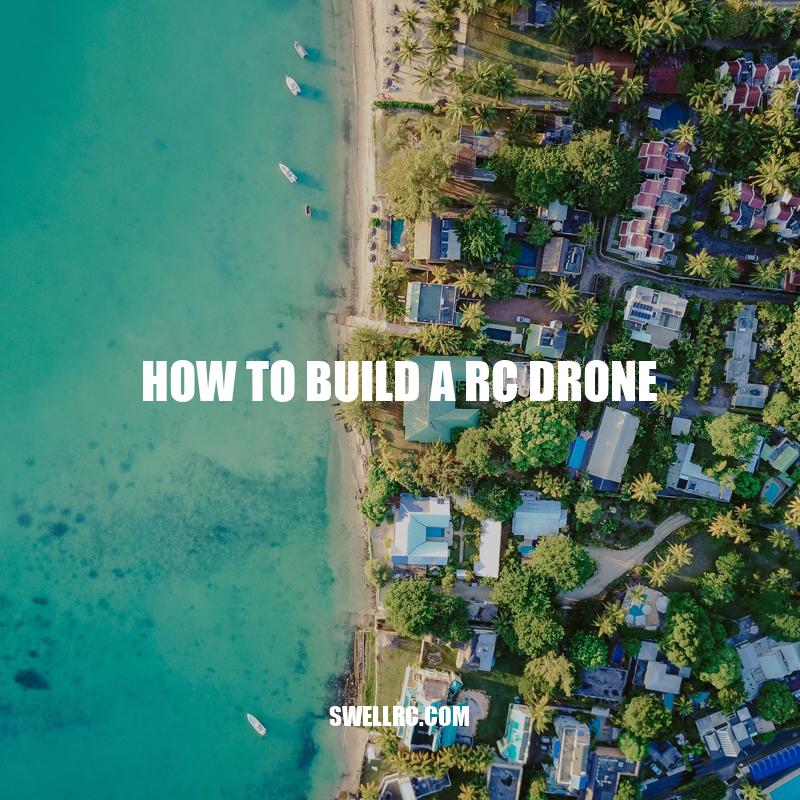Building an RC Drone: A Step-by-Step Guide
Remote control (RC) drones have become increasingly popular over the years, revolutionizing various industries, including photography, videography and surveying. These drones offer a unique vantage point, enabling users to capture breathtaking aerial footage or gain access to remote areas which would otherwise be impossible to reach. Although you can buy a ready-made drone, building your own can be fulfilling and cost-effective. Additionally, you get to customize your drone to fit your specific needs and preferences. Building an RC drone from scratch might seem daunting, but it’s not as hard as you might think. With the right parts, tools, and a step-by-step guide, you can craft one that meets your needs and performs better than off-the-shelf models. In this guide, we’ll show you the essential components required for building an RC drone, how to assemble these components and calibrate them for optimal performance. By the end of this guide, you’ll know how to build your drone like a pro.
Choosing the Right Parts
When building an RC drone, you need to choose the best components for high performance and functionality. Here are some tips to guide you:
Frame
– Material: Choose between carbon fiber, aluminum or plastic
– Shape: Quad, hexa or octa depending on your needs and drone size
– Durability: Consider how rugged you need the frame to be based on intended usage
Flight Controller
– Type: Choose between Arduino-based or proprietary types
– Compatibility: Ensure it’s compatible with the rest of your components
– Features: Look for features like GPS, gyro stabilization, and barometer
Motors
– Size: Consider the size of your drone for the proper fitting
– KV rating: Ensure the motors have the required speed
– Durability: Look for motors made for high durability
LiPo Battery
– Capacity: Choose one with enough power to fly your drone
– Voltage: The voltage should be adequate for your motors
– Charger: Look for a charger made for your battery
Online stores, such as Amazon or HobbyKing, have a wide range of parts available to make the selection process easier.
What is the basic principle of drone?
Drones work on the principle of remote control, automation, and autonomous control. The basic components of a drone include a frame, motors, propellers, electronic speed controllers, battery, and a flight controller. The flight controller is the brain of the drone that receives and processes information from various sensors such as gyroscope, accelerometer, magnetometer, and GPS. Based on this information, the flight controller sends commands to the electronic speed controllers that regulate the speed of the motors and propellers, thus controlling the movement and direction of the drone.
For more information on drones and their applications, you can visit websites such as DJI, a leading manufacturer of drones, or DroneDeploy, a platform for aerial data and analytics.
Assembling the Parts
Now that you have all the parts required for building an RC drone, it’s time to put them all together. Here’s a step-by-step guide to assembling the drone:
Tools required
- Soldering station
- Hex screwdriver set
- Cable ties
- Pliers
- Wire cutters
- Glue
Steps for assembling
- Attach the motors to the frame using screws and make sure they face in the right direction.
- Fix the flight controller to the drone frame using vibration dampening pads and double-sided tape.
- Mount the LiPo battery on the frame using a Velcro strap or cable ties.
- Install the receiver, antenna and video transmitter on the drone frame in their respective locations.
- Solder the wires according to the wiring diagram of your drone.
- Secure the loose wires with cable ties to improve aesthetics and avoid accidents during flight.
- Test the drone’s mechanical parts, motor speeds and flight controller using an open source Flight software e.g. Betaflight
Note that you should assemble the parts in a clean, well-lit workspace to avoid losing or damaging any small parts. Also, keep all the screws, tools and components in a safe place to avoid losing them.
Assembly Tips:
- Double check the wiring diagram before starting.
- Refer to the manual of each component before assembling it.
- Have a friend or family member help in assembling the drone.
How long does it take to assemble a drone?
Assembling a drone can take anywhere from 30 minutes to several hours, depending on the complexity of the drone and the experience level of the assembler. It is important to carefully follow the instructions provided by the manufacturer and take necessary safety precautions.
Some websites, such as DJI and Parrot, offer video tutorials and detailed instructions for assembling their drones. Other products, like the Syma X5UW-D, come pre-assembled, making it quick and easy to get started. Regardless of the type of drone, it is important to set aside enough time to assemble it properly and ensure a safe and successful flight.
Wiring and Setup
After assembling your drone, it’s time to wire it up and set it up for flight. Here are some important points to keep in mind:
Wiring the Drone
– Connect the motor wires to the ESCs, and then connect the ESCs to the PDB.
– Connect the receiver wires to the flight controller.
– Connect the battery wires to the PDB.
– Connect the video transmitter and camera input wires to the flight controller.
Setting up the Drone
– Install the Betaflight software on your computer.
– Connect your drone to your computer using a USB cable.
– Configure the Betaflight settings, such as the receiver, modes, and OSD displays.
– Test your drone by moving the controls in the Betaflight terminal or via a Radio transmitter once Connection is successful
Note: Be sure to follow the wiring diagram and Betaflight manual to avoid any mishaps in the setup process.
Betaflight Resources:
Betaflight is one of the most popular open-source software for configuring drones. If you’re a beginner to Betaflight, you can check out the following resources to learn more:
– Betaflight User Manual: A comprehensive guide to betaflight found at
– Betaflight YouTube channel: A channel that provides video guides on configuring and setting up a drone in Betaflight.
– Betaflight Support Group on Facebook: A supportive Facebook community where you can ask questions and learn from experienced drone builders.
How do I set up a new drone?
Here are the basic steps to set up a new drone:
- Charge your drone and remote control
- Install the propellers correctly
- Pair the drone and remote control
- Calibrate the drone’s compass and accelerometer
- Update firmware, if necessary
For more specific instructions, refer to your drone’s user manual or the manufacturer’s website. Additionally, many drone manufacturers have online communities or forums where you can ask questions and get support from other users.
Calibration
The last step before takeoff is to calibrate your drone. Calibration ensures that the drone is perfectly level and knows what is down. Without proper calibration, the drone may fly off balance or not remain in control. Here’s how to calibrate your drone:
Accelerometer Calibration
– Place the drone on a flat surface
– Connect the battery and wait until the drone has finished booting up.
– Hold the drone level and upright, then go to the Betaflight software click the “Calibrate Accelerometer” button.
Compass Calibration
– Rotate the Drone slowly through 360 Degrees while keeping it level. Complete this process 3 times
– In Betaflight software, go to the “Calibrate Compass” button.
Gyro Calibration
– Place the drone on a flat surface
– Locate the tab “Gyroscope” on the Betaflight application and click the “Calibrate Gyro” button and wait.
– Hold the drone still and upright till calibration is completed.
Note: Every drone’s calibration method may differ slightly, depending on the manufacturer’s instructions.
How Often Should You Calibrate Your Drone?
It’s necessary to calibrate your drone before the first flight and every time the drone is assembled or swapped with a new component. Remember to examine the gyro every few months or each time you notice peculiar behavior in your drone.
Additional Resources
– FPV Know-It-All provides an extensive guideline on drone calibration found at https://www.fpvknowitall.com/ultimate-fpv-shopping-list/fpv-drone-building-bootcamp/calibrate-drone/.
– Rotary Academy offers a video session on how to calibrate a drone’s compass found at https://www.rotorriot.com/pages/rotor-riot-fpv-diy-drone-videos.
How do I calibrate my DJI drone?
To calibrate your DJI drone, follow these steps:
- Choose an open, flat area with minimal interference.
- Disable your smartphone’s Wi-Fi and Bluetooth.
- Turn on your drone and remote controller.
- Connect your phone to the remote controller and open the DJI GO 4 app.
- Select your drone and go to the “Calibration” tab.
- Choose which calibration you need to perform (compass, IMU or gimbal).
- Follow the on-screen instructions to complete the calibration.
For more detailed guidance, visit the DJI support website or refer to your drone’s manual.
Flight Testing
Before taking the drone out for its first flight, it’s essential to test its functionalities. The following steps will help ensure that your drone is safe and ready for takeoff:
Battery and Drone Status Check
– Before commencing the test, ensure the battery is charged fully.
– Power on the remote control and connect it to the drone while establishing a strong connection.
– Verify all propellers’ nuts are tight and perform a drone status check.
Pre-test Check
– Conduct a pre-flight checkup of the drone to ensure that none of its components have loosened or malfunctioned from the inside out.
– Confirm all the necessary conditions before takeoff: weather, flying path, obstacles, and other potential environmental hazards.
Indoor Tests
– Conduct indoor tests first to avoid damage or loss of the drone. It also helps ensure proper coordination and operation of the drone’s various functions
– Try to control the drone’s stability, response, and stability in all directions to ensure it’s operating correctly.
Outdoor Tests
– Conduct an outdoor test if the indoor test passed, and you are ready to put your drone to the test.
– Observe the drone during takeoff, flight, and landing. It should correctly lift off the ground, operate correctly from a range of distances, and respond accurately to each command.
Safety Guide
– Always observe safety while testing, and take necessary precautionary measures.
– Some recommended measures include avoiding flying near people, animals, or structures, and landing immediately if you sense any danger.
Additional Resources
– The Federal Aviation Administration (FAA) provides guidelines on drone safety and flying.
– The DroneU is a comprehensive platform for tutorials, advice, and updated drone news.
How do you control a drone for the first time?
Controlling a drone for the first time may seem challenging, but with these simple steps, you will be able to fly your drone safely in no time:
- Get familiar with your drone’s controller: understand what each button or feature does, and make sure you know how to turn the drone on and off.
- Check for obstacles: clear the area of any potential obstacles that could harm the drone or other people.
- Calibrate the drone: make sure that the drone is level and properly calibrated before taking off.
- Take off slowly: start by hovering low and flying forward slowly. Get a feel for how the drone responds to your controller.
- Practice in open areas: avoid flying in areas with obstructions or crowds while you are learning.
- Keep an eye on battery life: monitor the battery level to make sure the drone does not run out of power and crash.
It is also recommended that you read the instruction manual that comes with your drone, and follow all the safety guidelines. Additionally, some drones come with beginner modes that limit the drone’s altitude and speed, making it easier for new pilots to learn.
For more information on drone flying, check out websites such as DJI or FAA.gov.
Conclusion
Building an RC drone can be a rewarding experience and a great way to learn new skills. With this step-by-step guide, you’ll be able to build your RC drone, efficiently and safely.
To sum up, building an RC drone requires an understanding of the essential parts, tools, and their functions. You’ll need to assemble the parts correctly, connect the wiring, and perform calibration with a multimeter. Finally, you need to test your drone indoors and outdoors and follow safety guidelines to ensure a safe and smooth flying experience.
It’s also important to note that different drones have different kit components, and some drones require more advanced skill sets than others. Always consult your drone’s manual and the experts at your local hobby shop for guidance.
Building an RC drone provides a beautiful sense of accomplishment and a way to unleash your creativity. With the tips and information provided in this guide, you are well on your way to building and flying your very own RC drone. Happy building!



